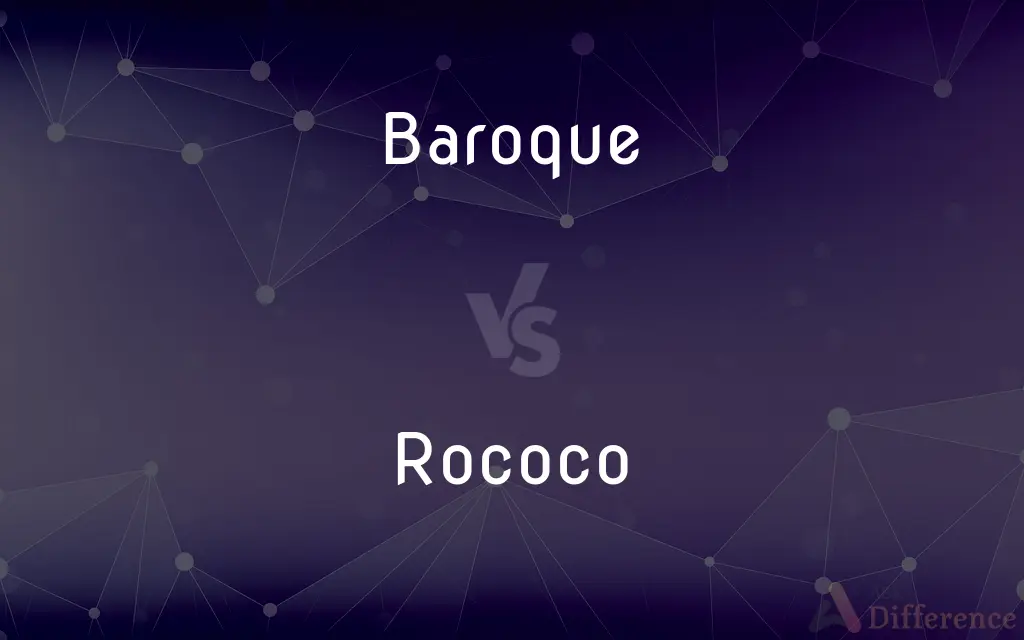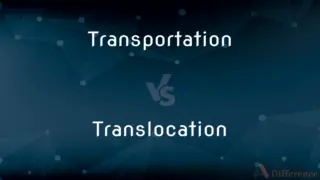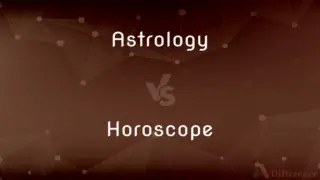Baroque vs. Rococo — What's the Difference?
Edited by Tayyaba Rehman — By Fiza Rafique — Updated on September 26, 2023
Baroque is style of art and architecture known for its ornate and dramatic features, characterized by grandeur and complexity. Rococo an artistic and architectural style that followed Baroque, featuring lighter, more ornate, and playful designs.

Difference Between Baroque and Rococo
Table of Contents
ADVERTISEMENT
Key Differences
Baroque: Flourished in the 17th century. Rococo: Emerged in the early 18th century.
Baroque: Emphasized grandeur, drama, and complexity. Rococo: Focused on lightness, elegance, and asymmetry.
Comparison Chart
Time Period
Flourished in the 17th century
Emerged in the early 18th century
Style Features
Grandeur, complexity, bold contrasts
Lightness, elegance, asymmetry, ornamentation
Emotional Intensity
Emphasis on emotional intensity
Tended to be more playful and whimsical
ADVERTISEMENT
Common Applications
Often used in churches and palaces
Frequently used in interior design, furniture
Prominent Artists
Caravaggio, Bernini
Watteau, Boucher
Compare with Definitions
Baroque
"Baroque" refers to an ornate and dramatic style.
Rococo
"Her living room had a rococo-inspired decor."
Baroque
A rich, 17th-century artistic style.
Rococo
Known for its intricate and charming designs.
Baroque
Known for grand architectural designs.
Rococo
A light and whimsical 18th-century style.
Baroque
"The baroque paintings evoke powerful emotions."
Rococo
"The rococo furniture was adorned with delicate carvings."
Baroque
"The baroque cathedral featured intricate sculptures."
Rococo
Rococo (, also US: ), less commonly Roccoco or Late Baroque, is an exceptionally ornamental and theatrical style of architecture, art and decoration which combines asymmetry, scrolling curves, gilding, white and pastel colors, sculpted molding, and trompe-l'œil frescoes to create surprise and the illusion of motion and drama. It is often described as the final expression of the Baroque movement.The Rococo style began in France in the 1730s as a reaction against the more formal and geometric Style Louis XIV. It was known as the style rocaille, or rocaille style.
Baroque
The Baroque (UK: , US: ; French: [baʁɔk]) is a style of architecture, music, dance, painting, sculpture, and other arts that flourished in Europe from the early 17th century until the 1740s. In the territories of the Spanish and Portuguese empires including the Iberian Peninsula it continued, together with new styles, until the first decade of the 1800s.
Rococo
A style of art, especially architecture and decorative art, that originated in France in the early 1700s and is marked by elaborate ornamentation, as with a profusion of scrolls, foliage, and animal forms.
Baroque
AlsoBaroqueOf, relating to, or characteristic of a style in art and architecture developed in Europe from the early 17th to mid-18th century, emphasizing dramatic, often strained effect and typified by bold, curving forms, elaborate ornamentation, and overall balance of disparate parts.
Rococo
A very ornate style of speech or writing.
Baroque
AlsoBaroque(Music)Of, relating to, or characteristic of a style of composition that flourished in Europe from about 1600 to 1750, marked by expressive dissonance and elaborate ornamentation.
Rococo
(Music) A style of composition arising in the 1700s in France, often viewed as an extension of the baroque, and characterized by a high degree of ornamentation and lightness of expression.
Baroque
Extravagant, complex, or bizarre, especially in ornamentation:"the baroque, encoded language of post-structural legal and literary theory"(Wendy Kaminer).
Rococo
Also Rococo Of or relating to the rococo.
Baroque
Irregular in shape:baroque pearls.
Rococo
Immoderately elaborate or complicated.
Baroque
The baroque style or period in art, architecture, or music.
Rococo
(uncountable) A style of baroque architecture and decorative art, from 18th-century France, having elaborate ornamentation.
Baroque
Ornate, intricate, decorated, laden with detail.
Rococo
(countable) A piece of ornamentation in this style.
Baroque
Complex and beautiful, despite an outward irregularity.
Rococo
Of or relating to the rococo style.
Baroque
Chiseled from stone, or shaped from wood, in a garish, crooked, twisted, or slanted sort of way, grotesque.
Rococo
Over-elaborate or complicated; opulent.
Baroque
Embellished with figures and forms such that every level of relief gives way to more details and contrasts.
Rococo
Old-fashioned.
Baroque
Characteristic of Western art music of about the same period.
Rococo
A florid style of ornamentation which prevailed in Europe in the latter part of the eighteenth century.
Baroque
(figuratively) Overly and needlessly complicated.
Grotesquely baroque bureaucratic hassles
Baroque bookkeeping in pursuit of tax dodges
Rococo
Of or pertaining to the style called rococo; like rococo; florid; fantastic.
Baroque
An ornate, detailed style.
Rococo
Fanciful but graceful asymmetric ornamentation in art and architecture that originated in France in the 18th century
Baroque
Of, pertaining to, or characteristic of, an artistic style common in the 17th century, characterized by the use of complex and elaborate ornamentation, curved rather than straight lines, and, in music a high degree of embellishment.
Rococo
Having excessive asymmetrical ornamentation;
An exquisite gilded rococo mirror
Baroque
Hence, overly complicated, or ornamented to excess; in bad taste; grotesque; odd.
Rococo
"Rococo" is an elegant, playful artistic style.
Baroque
Irregular in form; - said esp. of a pearl.
Baroque
Elaborate an extensive ornamentation in decorative art and architecture that flourished in Europe in the 17th century
Baroque
Having elaborate symmetrical ornamentation;
The building...frantically baroque
Common Curiosities
What is Baroque?
Baroque is an ornate and dramatic artistic style of the 17th century.
What are some features of Baroque art and architecture?
It emphasizes grandeur, complexity, and emotional intensity.
Who were notable Baroque artists?
Caravaggio and Bernini are renowned Baroque artists.
Where can I find examples of Baroque architecture?
It's often seen in churches and palaces.
Where was Rococo commonly applied?
Rococo was frequently used in interior design and furnishings.
How does Baroque differ from Rococo?
Baroque is characterized by grandeur, while Rococo is more playful.
What is Rococo?
Rococo is an elegant and playful artistic style of the 18th century.
Who were notable Rococo artists?
Watteau and Boucher are famous Rococo artists.
What defines Rococo design?
It features lightness, elegance, asymmetry, and intricate ornamentation.
How does Rococo differ from Baroque?
Rococo is lighter and more whimsical, contrasting with Baroque's grandeur.
Share Your Discovery

Previous Comparison
Transportation vs. Translocation
Next Comparison
Astrology vs. HoroscopeAuthor Spotlight
Written by
Fiza RafiqueFiza Rafique is a skilled content writer at AskDifference.com, where she meticulously refines and enhances written pieces. Drawing from her vast editorial expertise, Fiza ensures clarity, accuracy, and precision in every article. Passionate about language, she continually seeks to elevate the quality of content for readers worldwide.
Edited by
Tayyaba RehmanTayyaba Rehman is a distinguished writer, currently serving as a primary contributor to askdifference.com. As a researcher in semantics and etymology, Tayyaba's passion for the complexity of languages and their distinctions has found a perfect home on the platform. Tayyaba delves into the intricacies of language, distinguishing between commonly confused words and phrases, thereby providing clarity for readers worldwide.
















































